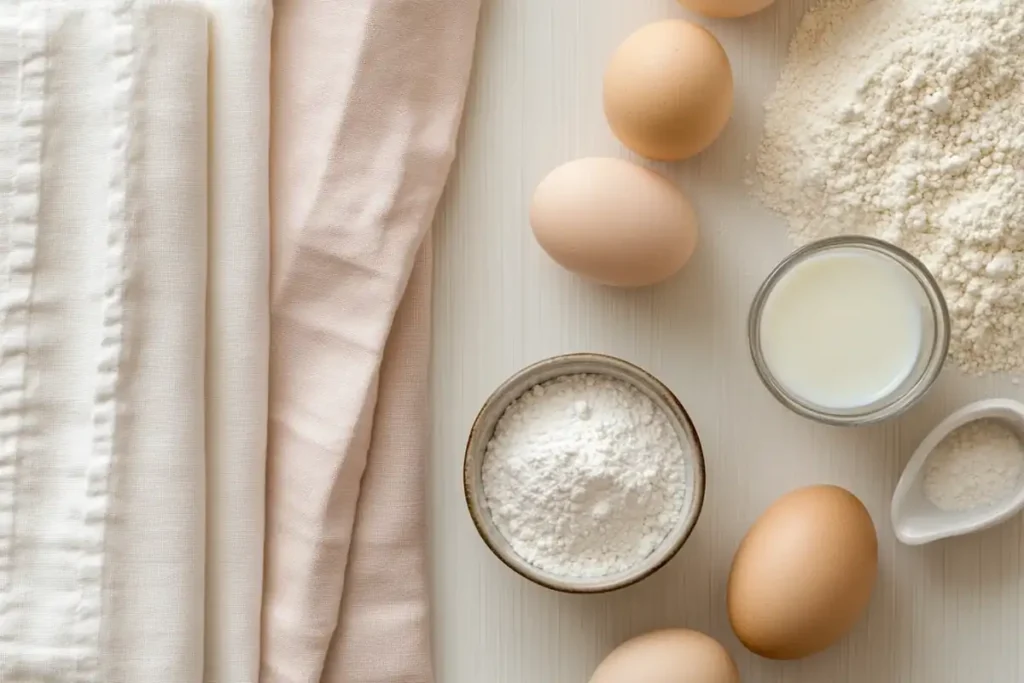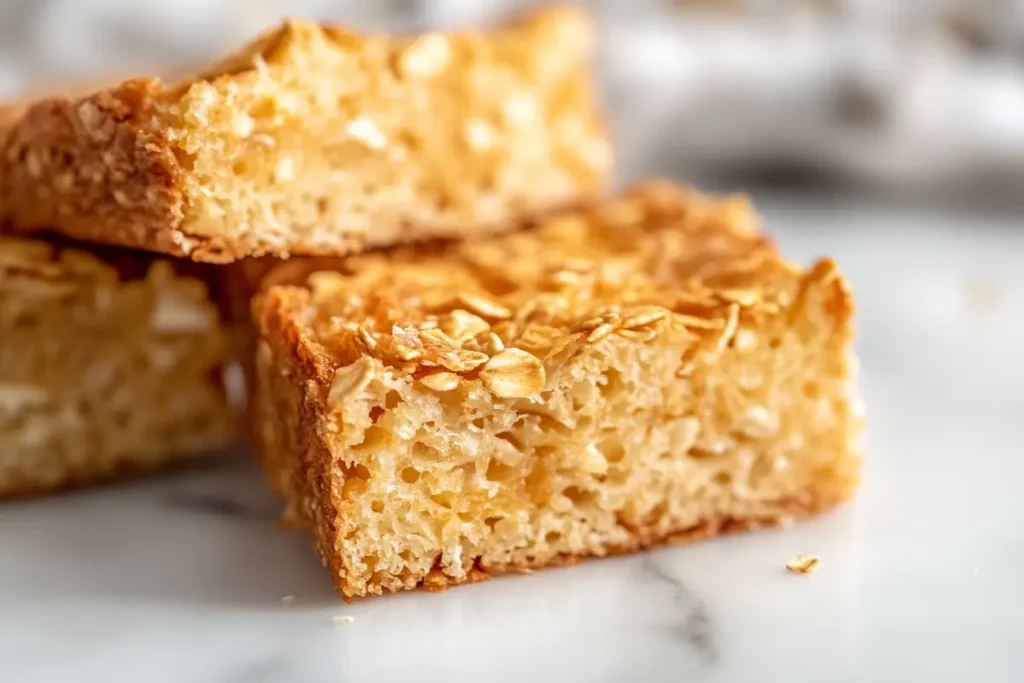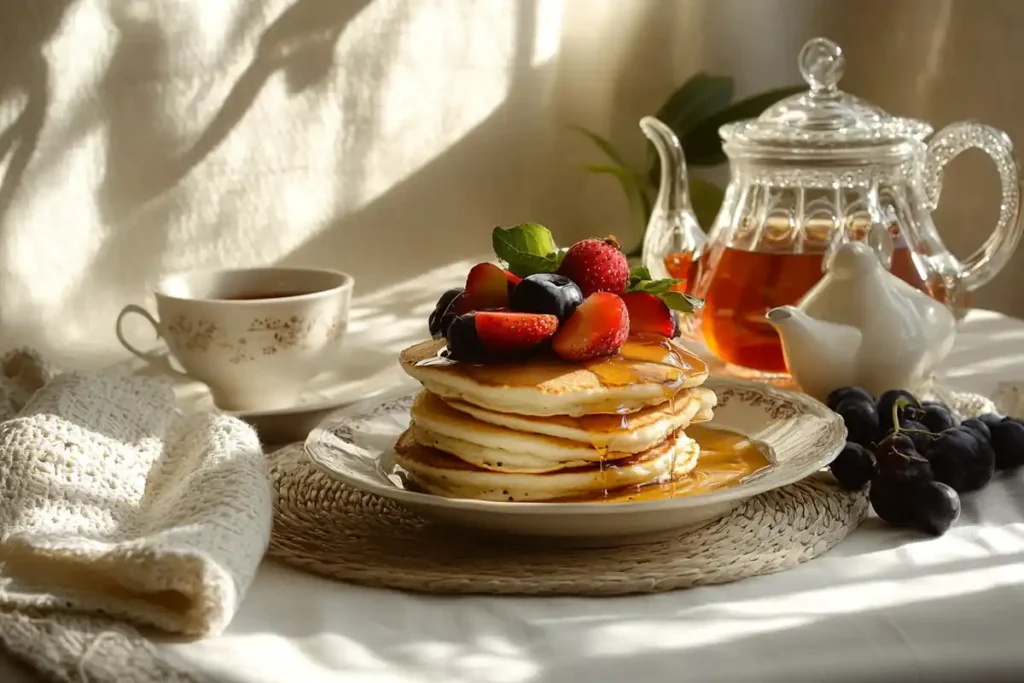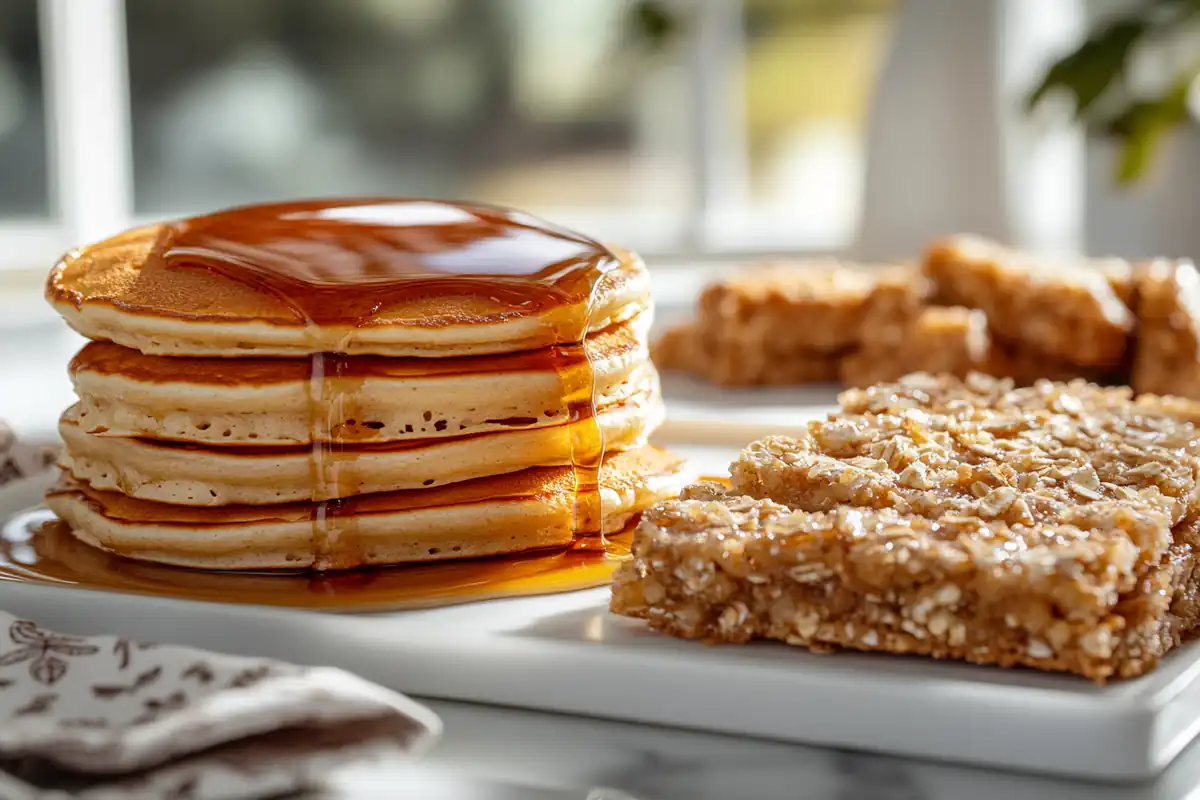What is the difference between pancakes and flapjacks? This article breaks down their key differences, from origins and ingredients to the best ways to enjoy them.
What is the difference between pancakes and flapjacks? A Detailed Look
People often wonder what is the difference between pancakes and flapjacks? While both are breakfast staples, they have unique origins and characteristics. The terms are sometimes used interchangeably, leading to confusion. Therefore, it’s essential to understand the key differences between these tasty treats. Let’s dive deeper into this delicious debate.
Historical Origins of Pancakes and Flapjacks
To understand what is the difference between pancakes and flapjacks, it’s useful to explore their past. Pancakes have ancient roots, appearing in various forms across cultures. Ancient Greeks and Romans made them with wheat flour and honey. Flapjacks, on the other hand, have a more specific history. The term initially described a flat, oat-based cake. Therefore, the historical paths of these two breakfast items are distinct.
Pancake History
Pancakes can be traced back to the Stone Age. Early versions involved simple mixtures cooked on hot stones. Over time, recipes evolved, incorporating new ingredients. This means pancakes have a long and varied past. Furthermore, pancakes adapted to different cultures, each adding their own spin. These historic influences contribute to the diverse pancake styles we see today.
Flapjack History
Flapjacks have a different timeline. They first appeared as a type of oat cake. Early versions were a mix of oats, butter, and sugar. This combination created a dense, chewy treat. The term “flapjack” was also used in the past, sometimes to describe a thin pancake. However, the term became associated with the oat-based bar, specifically in the UK. Therefore, understanding their past clarifies their present forms.
Key Ingredient Differences Between Pancakes and Flapjacks

What is the difference between pancakes and flapjacks regarding their core ingredients? The contrast lies mostly in the type of flour used. Pancakes typically use wheat flour for a light and fluffy texture. Flapjacks, especially in the UK, prominently feature oats for a dense and chewy result. Let’s examine the typical ingredient lists in more detail.
Typical Pancake Ingredients
Standard pancake recipes commonly include:
- Wheat flour
- Milk
- Eggs
- Baking powder
- Sugar
- Butter or oil
These create a batter that cooks into light, airy rounds. Additionally, vanilla extract or other flavorings are sometimes added for an extra touch. These ingredients, therefore, contribute to the classic pancake texture.
Typical Flapjack Ingredients
Flapjacks often use:
- Oats
- Butter
- Sugar or syrup (like golden syrup)
- Sometimes dried fruit or nuts
These components are mixed to form a sturdy, baked bar. Consequently, flapjacks are quite different from the light consistency of pancakes. Therefore, the ingredient mix greatly impacts the texture and taste.
Texture and Appearance: Pancake vs Flapjack

The difference between a pancake and a flapjack is also evident in their texture and look. Pancakes are known for their soft, fluffy, and light texture. Conversely, flapjacks are often dense, chewy, and sometimes even crunchy. Moreover, their appearances differ as well.
Pancake Texture
Pancakes are prized for being soft and airy. The use of baking powder creates a lift, resulting in that iconic fluffy texture. Furthermore, they cook quickly and easily absorb toppings. Therefore, pancakes offer a delightful eating experience, especially when drizzled with syrup. Their lightness, therefore, is a key defining characteristic.
Flapjack Texture
Flapjacks, on the other hand, have a dense, chewy or crispy texture. The high oat content and baking method create a very solid bar. Often baked in a pan, flapjacks hold their shape well. Consequently, this texture makes them a convenient snack or breakfast item. The chewiness, therefore, is a defining feature of the flapjack.
Cooking Methods
Cooking methods also help show what is the difference between pancakes and flapjacks. Pancakes are usually cooked on a griddle or frying pan. Flapjacks are usually baked in an oven. Thus, the difference in heat application also contributes to their unique end result.
Cooking Pancakes
Pancakes are made by pouring batter onto a hot, lightly greased surface. They are cooked over medium heat, flipped once bubbles form on the surface. This method is quick and produces a light, golden brown cake. Additionally, this process helps create a tender interior. Therefore, the griddle technique is key for perfect pancakes.
Cooking Flapjacks
Flapjacks are prepared by pressing the oat mixture into a baking pan. They are then baked in an oven until golden brown. The baking process causes the ingredients to bind together and harden. Consequently, the oven is essential to achieving the correct consistency and chewiness. Therefore, the baking process is different and provides a very different outcome.
Cultural Differences and Terminology
It’s important to discuss how what is the difference between pancakes and flapjacks varies across different regions. For example, in the U.S., “flapjack” is often another name for a pancake. However, in the UK, a flapjack typically refers to the oat bar. The differences in terminology and usage can be a little confusing, so it is important to understand how cultures use these words.
American Usage
In the United States, “flapjack” is essentially a synonym for “pancake.” The term is often used interchangeably, adding to the overall confusion. Therefore, if someone asks for a flapjack in the U.S., they are likely expecting a standard pancake. Indeed, the term has become a more informal or old-fashioned way to say pancake.
British Usage
In the UK, however, a flapjack is decidedly not a pancake. It describes a baked oat bar, often chewy and sweet. Therefore, asking for a flapjack in the UK will get you something very different. This difference in terminology can lead to much misunderstanding between Americans and British. Therefore, knowing these cultural distinctions is very helpful.
Serving Suggestions and Enjoyment

Both pancakes and flapjacks are beloved treats, but they offer different culinary experiences. Their serving suggestions and enjoyment methods vary considerably. Flapjacks often make a good snack, while pancakes are usually enjoyed as part of a breakfast meal.
Serving Pancakes
Pancakes are often served as part of a traditional breakfast. Common toppings include maple syrup, butter, fresh fruit, whipped cream and chocolate sauce. Indeed, pancakes are a blank canvas for endless delicious combinations. Therefore, they offer a very customisable eating experience.
Serving Flapjacks
Flapjacks are more commonly enjoyed as a snack or on-the-go treat. They are often eaten plain or with a cup of tea or coffee. Flapjacks can provide a quick boost of energy, making them suitable for hiking or other outdoor activities. Furthermore, this makes them a convenient and satisfying choice.
Health and Nutrition Considerations
When thinking about what is the difference between pancakes and flapjacks from a health perspective, it’s necessary to consider their nutritional makeup. Pancakes can be relatively light and easily incorporated into a balanced meal. Flapjacks, especially those with high sugar and butter content, should be eaten in moderation.
Nutritional Profile of Pancakes
Pancakes, when made with whole wheat flour and moderate amounts of sugar, can offer a decent source of fiber and carbohydrates. Additionally, eggs add some protein. Therefore, choosing healthier ingredients can make them a more nutritious option. This, therefore, is a key point for anyone considering their diet.
Nutritional Profile of Flapjacks
Flapjacks usually contain more calories and sugar compared to pancakes. The high fat content from butter can also be a consideration. Therefore, while flapjacks can provide some energy, they are usually best consumed as an occasional treat. Furthermore, careful portion control is very important here.
Pancake and Flapjack Variations: An Exploration
When exploring what is the difference between pancakes and flapjacks, it’s also worth noting that many variations exist. Both can be customized based on regional preferences and taste. There are many recipes out there, making both quite diverse.
Pancake Variations
Pancakes come in countless variations: blueberry, chocolate chip, banana and buttermilk are just some examples. Additionally, some people prefer thinner, crepe-like pancakes while others prefer thicker versions. Therefore, pancakes are incredibly flexible and can be easily adapted to different tastes. This flexibility is just one of their many characteristics.
Flapjack Variations
Flapjacks can include nuts, seeds, dried fruits, or chocolate. Some people use honey or maple syrup instead of refined sugar for their sweetener. Therefore, even with their basic structure, flapjacks also have plenty of room for recipe customization. Indeed, these adjustments can completely alter both the taste and nutritional profile.
The Importance of Understanding the Differences
Understanding what is the difference between pancakes and flapjacks goes beyond just distinguishing food items. It highlights cultural differences and traditions. Knowing these distinctions is also helpful when following recipes or travelling abroad. Therefore, these details matter for good communication, too.
Avoiding Confusion
The shared use of the term “flapjack” in the United States can lead to considerable confusion. Therefore, clarifying these differences helps prevent misunderstandings. When ordering food or sharing recipes, knowing the terms used is essential. This can significantly improve your culinary experiences.
Enjoying Food Traditions
Appreciating the distinctions between pancakes and flapjacks also helps us enjoy the richness of our food traditions. Each treat has its own story and cultural significance. Furthermore, by understanding their origins and how they are made, we can appreciate them that much more. Therefore, this brings greater depth to our food-related experience.
Deeper Dive into Pancake Ingredients
Let’s further explore pancake ingredients to understand how they contribute to texture and taste. While a basic pancake recipe is simple, the quality of ingredients can greatly affect the outcome. Therefore, understanding these nuances allows us to make the best pancakes at home. Furthermore, this knowledge enhances our overall baking abilities.
Flour Choices for Pancakes
The most common flour used in pancakes is all-purpose wheat flour. However, there are other options, like whole wheat or gluten-free blends. Indeed, each option impacts the texture and nutritional value. Whole wheat adds more fiber, making them healthier. Gluten-free options are good for those with dietary restrictions. Therefore, the choice of flour really matters.
Leavening Agents: Baking Powder
Baking powder is a key leavening agent in pancake recipes. It creates those air pockets which makes them light and fluffy. Without it, the pancakes would be dense and flat. Therefore, ensuring your baking powder is fresh is crucial for best results. Furthermore, the correct amount must be used for an ideal rise.
Liquid Choices: Milk and Alternatives
The liquid ingredient in pancakes is typically milk. However, buttermilk, or non-dairy milk can also be used. Buttermilk gives pancakes a tangy flavor and a more tender texture. Additionally, non-dairy milks work just as well and accommodate various dietary needs. Therefore, your choice of liquid changes the final product.
Sweeteners and Flavorings
While a little sugar is needed in most basic recipes, many other sweeteners can also be used. Honey, maple syrup, or even agave are good alternatives. Vanilla extract or cinnamon will also add warmth and depth. Therefore, adjusting these can completely change the final flavor. Indeed, such flavour adjustments are very important for customisation.
Deeper Dive into Flapjack Ingredients
Let’s now look at flapjack ingredients in more detail. The magic of flapjacks lies in the interaction between oats, butter, and sweeteners. These ingredients together produce that signature chewy or crispy texture we expect. Therefore, it’s good to know how each ingredient works to achieve this texture. Furthermore, understanding these mechanisms will help you make your own flapjack creations at home.
The Role of Oats
Oats are the heart of a flapjack. Rolled oats are the most typical choice, providing structure and a satisfying chewiness. Furthermore, different oat types, such as quick oats, will result in different textures. Therefore, selecting the right oats has a huge impact on the end result. Indeed, this is key when making flapjacks.
Butter and Its Effect
Butter provides both flavour and a binding element. It melts when baking, helping all of the dry ingredients cling together. Therefore, using good quality butter is important for both taste and texture. Indeed, this is not a step you should skimp on when making flapjacks. Furthermore, its fat content gives them a rich, satisfying taste.
Sweeteners and Binding
Sweeteners such as golden syrup, honey or refined sugar are vital in flapjacks. They provide sweetness and also act as a binder when melted. The type and amount will affect the consistency and chewiness. For example, honey tends to give a softer bar, and sugar will often be crispier. Therefore, choosing your sweetener is key for getting the right consistency.
Adding Dried Fruits and Nuts
Many flapjack recipes include dried fruits and nuts for both flavor and texture. Raisins, cranberries, and chopped nuts are common choices. Furthermore, these additions not only add flavor but also can improve the nutritional value. Therefore, this customization makes them even more versatile. Indeed, feel free to experiment with your own favorites.
Regional Variations in Detail
When further exploring what is the difference between pancakes and flapjacks, consider the regional variations. There are countless adaptations of both dishes worldwide. Each culture adds its own unique touches and preferences. Therefore, this diversity can completely transform the dishes. Furthermore, it enhances the enjoyment of these global classics.
Pancake Traditions around the World
Around the world, pancakes come in so many shapes, sizes, and flavours. For example, French crepes are very thin and delicate, while Japanese soufflé pancakes are incredibly light. Each culture puts their own unique spin on the base recipe. Therefore, pancakes can be enjoyed in a vast array of forms. Indeed, this diversity showcases the universality of pancakes.
Flapjack Variations Outside the UK
While flapjacks are most well-known in the UK, variations also exist elsewhere. Some places have adapted oat bar recipes, adding local flavors. These are not necessarily called flapjacks but show similar ingredient combinations. Therefore, these variations are interesting to explore to broaden your knowledge. Indeed, you can find oat-based bars throughout the world.
The Impact of Local Ingredients
Local ingredients play a key role in the adaptation of recipes. The available flours, sweeteners, and spices greatly influence the outcome. This often results in each region putting its own distinct stamp on these dishes. Therefore, these variations often lead to exciting and unexpected flavor combinations. This showcases the beauty of local cooking.
Pairing and Serving: Beyond the Basics
Let’s now go further in to pairing and serving both pancakes and flapjacks. While we know the basics, there are many more exciting ways to enjoy them. This can elevate the dining experience and add something special to every meal. Furthermore, knowing these tips will impress your friends and family.
Elevating Pancake Pairings
Beyond maple syrup and butter, pancakes pair well with various other toppings. Fresh fruits like berries, bananas, and peaches are excellent. A dollop of Greek yogurt will add some protein and creaminess. Additionally, a sprinkle of nuts or chocolate shavings can add texture and taste. Therefore, these additional toppings are worth exploring.
Creative Flapjack Serving Ideas
Flapjacks are not just for eating on their own; there are more exciting ways to enjoy them. Try serving them alongside a dollop of ice cream for a dessert. You can use them as the base for a breakfast parfait, layering with yogurt and fruit. Furthermore, crumble them over your morning oatmeal for added texture. Therefore, these ideas are worth experimenting with.
Pairing Pancakes and Flapjacks with Beverages
The right beverage can greatly compliment a meal. Pancakes are often enjoyed with coffee, tea, or juice. Flapjacks pair well with a cup of tea or a glass of milk. Therefore, selecting the best drink is essential for any great meal. Indeed, you’ll find this enhances the dining experience even further.
Healthier Alternatives and Adaptations
It is important to consider healthier alternatives and adaptations for both pancakes and flapjacks. You can easily modify these recipes to suit your dietary needs. These adjustments can make them more nutritious and aligned with your health goals. Furthermore, this means both dishes can be enjoyed by a wider variety of people.
Healthier Pancake Recipes
Using whole wheat or other high-fiber flours makes a good start to healthy pancakes. Instead of sugar, try using natural sweeteners such as honey or mashed banana. Also, add in some flax seeds or chia for added fiber. Therefore, these simple tweaks can help make your breakfast much more healthy. Indeed, every little change can have a big impact.
Healthier Flapjack Recipes
For healthier flapjacks, you can choose low-sugar sweeteners. Additionally, use less butter and add more nuts or seeds for protein and nutrients. You can also use whole grains and high fiber additions. Therefore, such changes can make them a more balanced snack. This means you can enjoy the taste without the guilt.
Conclusion
In summary, what is the difference between pancakes and flapjacks? Pancakes are generally light, fluffy, and made with wheat flour, while flapjacks are dense, chewy, and primarily made with oats. While the terms may be interchangeable in the U.S., they have very different meanings elsewhere, especially in the UK. Both are delicious in their own ways and offer unique culinary experiences. Therefore, understanding these distinctions enhances our ability to enjoy them to the fullest. Finally, by understanding their different ingredients, methods and usage, we can properly enjoy each.

